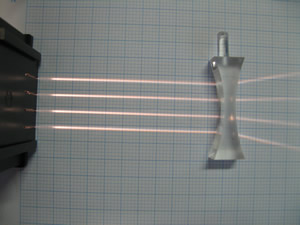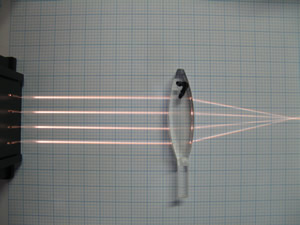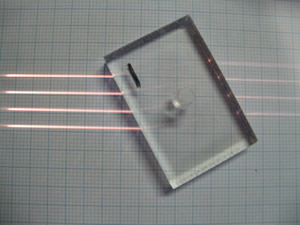Light Box activity
Refraction of light with transparent objects

Bending of light waves is known as refraction. Light can bend as it passes through different mediums which make slow down or speed up. As a consequence of this change of speed light will bend. Light is also refracted differently as it passes through different shaped objects.

1) Set up a concave lens as shown on the right. Draw the lines on the graph paper as they emerge from the lens. They look as though they are coming from a point somewhere between the lens and the light box. Trace back the lines and locate the point. Measure the distance it is from the midpoint of the lens. This is known as the focal length.
What type of image do you see when you look through a concave lens?
, ,
2) Set up a convex lens as shown on the right. Draw the lines on the graph paper as they emerge from the lens. They look as though they are passing through a common point beyond the lens. Trace the lines as they emerge from the lens and locate the point, measure its distance from the midpoint of the lens. This is known as the focal length.
What type of image do you see when you look at a distant object through a convex lens?
, ,
What type of image do you see when you look at an object up close through a convex lens?
, ,

3) Set up a convex lens as shown on the right. Draw the lines on the graph paper as they emerge from the lens. They look as though they are passing through a common point beyond the lens. Trace the lines as they emerge from the lens and locate the point, measure its distance from the midpoint of the lens. This is known as the focal length.
What can you say about the focal point of thin convex lenses compared to thick convex lenses.

4) Set up a rectangular prism as shown on the right. Trace the rays of light coming into the prism and coming out of the prism.
Draw the rays of light as they pass through the prism?
What is happening to the rays of light to deviate them from a straight path through the prism? They are
What would happen if the rays of light were perpendicular to the surface of the prism?

5) Set up a triangular prism as shown on the right. Trace the rays of light coming into the prism and coming out of the prism.
Draw the rays of light as they pass through the prism?
Ray "A" is formed by
Ray "B" is formed by

6) Set up a triangular prism as shown on the. Trace the rays of light coming into the prism and the rays of light coming out of the prism.
Draw the rays of light as they pass through the prism?
What do you predict would happen if the prism was turned around 180 degrees so the light rays would strike the flat surface as opposed to the curved surface? Solution

7) The eye can be represented by drawing a curved line behind a convex lens. For a perfect image to be seen the light must be focused directly on the retina. The light in this situation, as you can see, is focused well in front of the retina.
What can the lens do to accommodate?
If the lens can not change to focus the image on the retina then glasses are prescribed. What type of lens placed in front of the convex lens do you think will work? Explain
Solution

8) What type of image is formed by the lens? , ,
The lens must be

9) A diamond must be cut just right in order for it to shine with maximum brightness and effect. Explain why the dimensions of the cut of the diamond as well as its shape are critical.
If the diamond is cut
- properly
- too deep
- too shallow

Ray "A" is formed by
Ray "B" is formed by
